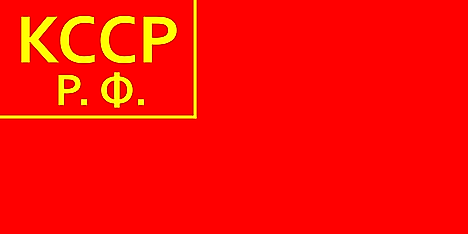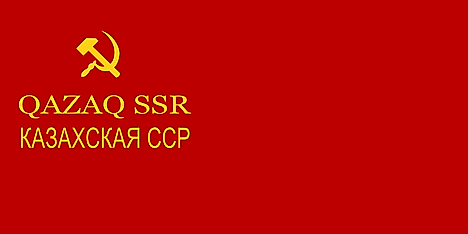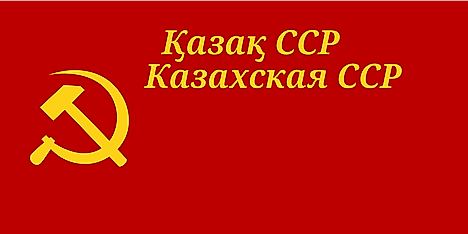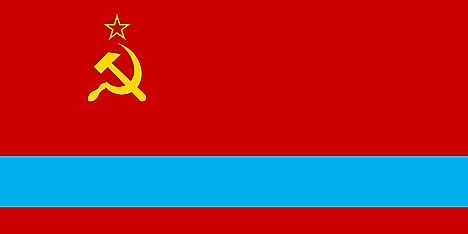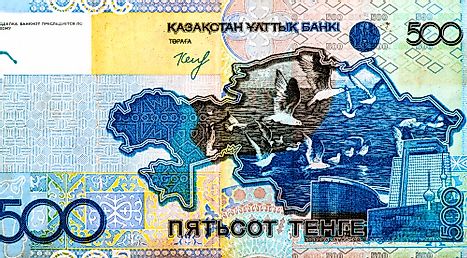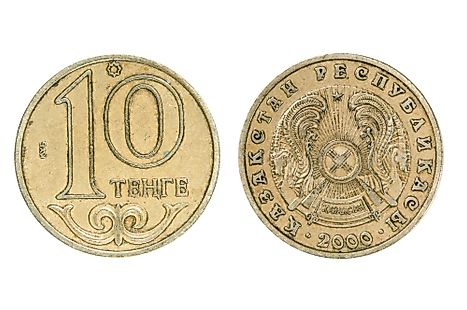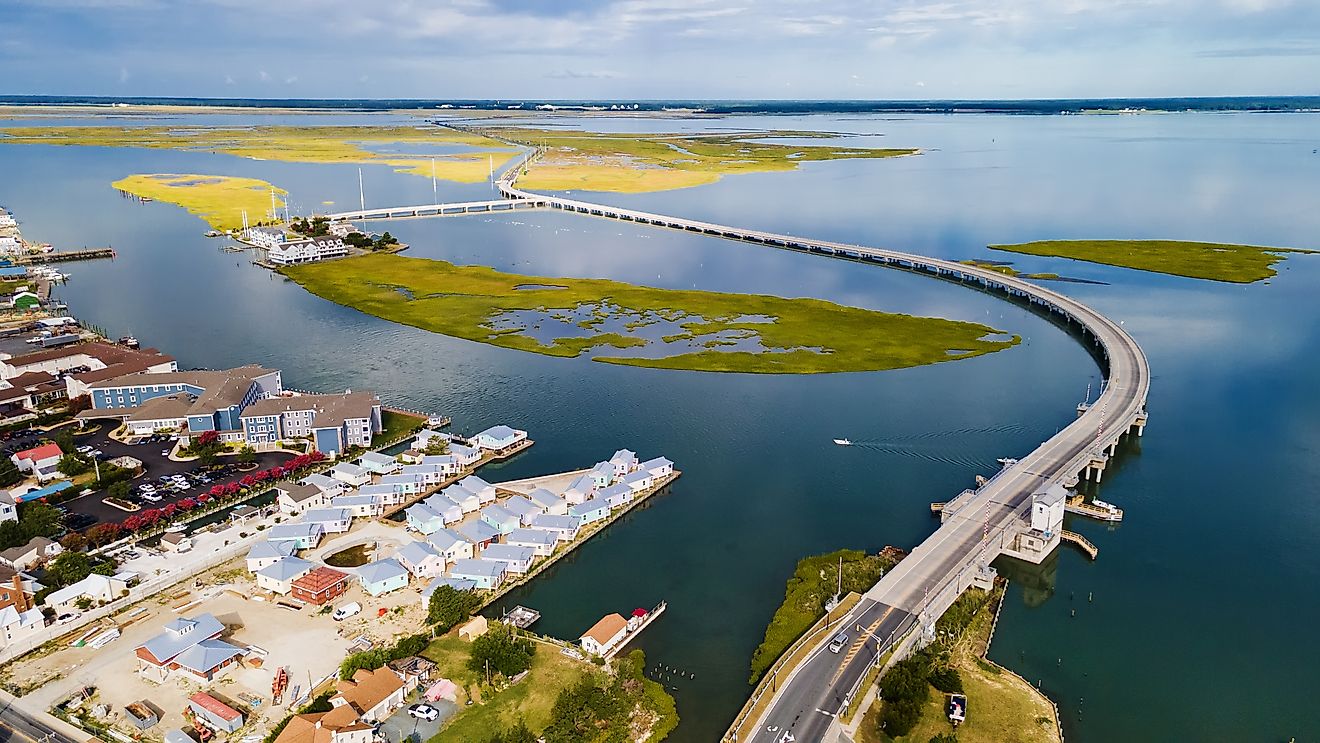Flags, Symbols, & Currencies of Kazakhstan
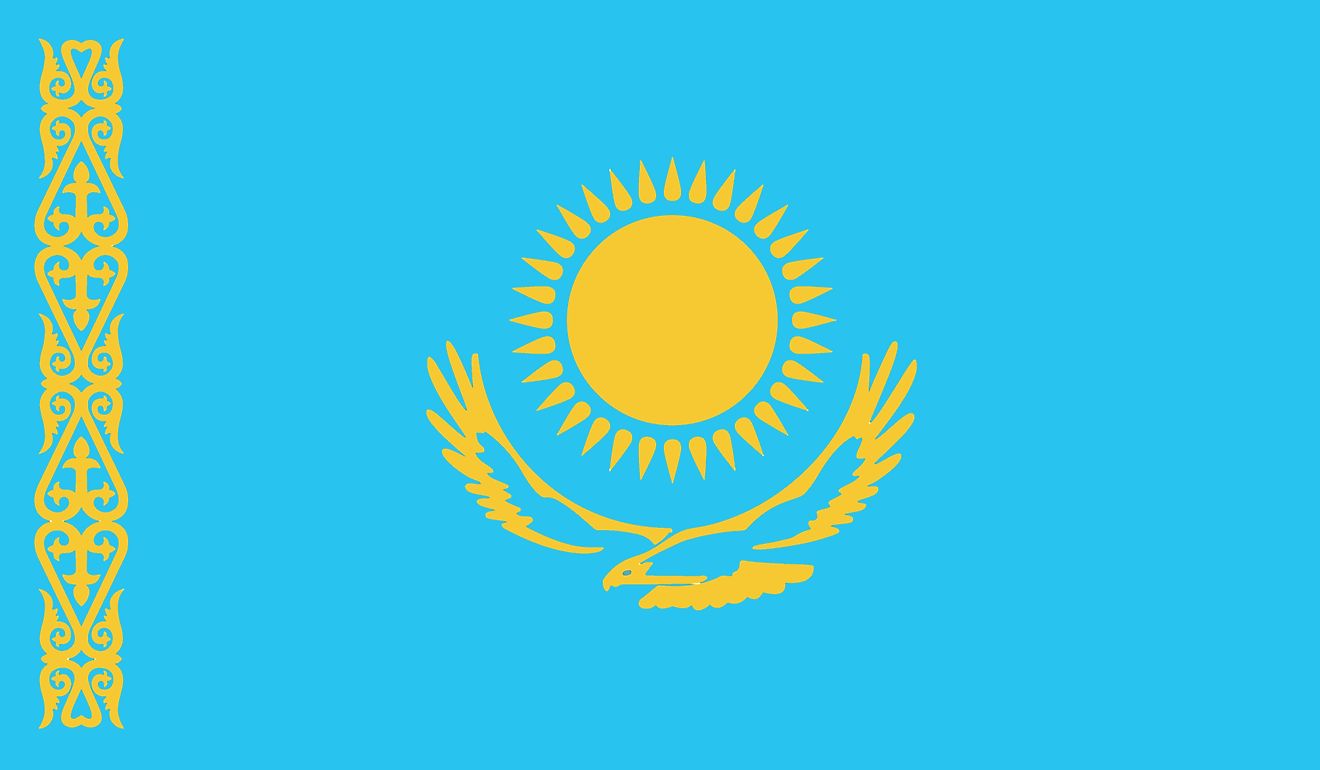
The flag of Kazakhstan was adopted on June 4, 1992. It was designed by Shaken Onlasynovich Niyazbekov as a replacement of the flag of the Kazakh Soviet Socialist Republic. The main feature of the flag is its light blue color. The center of the flag has a golden sun with 32 rays. The sun rays are shaped like wheat grain. Flying nearby under the sun is the soaring golden eagle. The eagle appears to be protecting the sun. The hoist side of the flag consists of a national ornamental pattern. The pattern is referred to as the “koshkar-muiz” meaning the horn of the ram. The ornamental pattern is also gold in color. The ratio of the width to the length of the flag is 1:2.
The light blue color of the flag is a symbol of the endless sky and water. This color also symbolizes the cultural and ethnic unity of the people of Kazakhstan such as the Kazakhs, Uzbeks, Uyghurs, Tatars, and Russian and Mongol people. The light blue color is also a symbol of peace and the indivisibility of Kazakhstan as a country. The color of the sky also implies purity, honesty, integrity, freedom, fidelity, and infinity. The blue color is also a religious symbol of the Turkic people.
The golden sun is a symbol of life and energy. The sun also symbolizes time and progress besides wealth and plenitude. The wheat ray area is a symbol of abundance and prosperity. The golden eagle symbolizes the state’s power and its astuteness. It’s also a symbol of the state’s sovereignty and independence. The eagle also represents independence, freedom, and the Kazakhstan people's flight to the future. It is a symbol of strength to oppose anyone preventing the people of Kazakhstan from reaching higher goals. The eagle also symbolizes the attempt of Kazakhstan’s people become an important part of the world’s civilization. The “koshkar-muiz” or the horn of the ram pattern on the flag represents the culture and art of the people of Kazakhstan.
Historical Flags
The blue and gold colors of the flag were preserved from the flag of the Soviet era abandoning the red color. The flag of the Soviet era had a hammer and a sickle in gold color and a cyan bar close to the bottom of the flag. Historically, several other flags were flown in Kazakhstan, among them the alleged flag of the Kazakh Khanate, Flag of the Alash Autonomy, and several versions of the Flag of the Kazakh Soviet Socialist Republic.
Symbols of Kazakhstan
National Coat of Arms of Kazakhstan
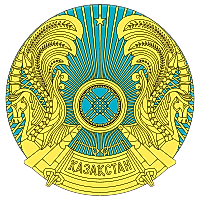
Adopted on June 4, 1992, the emblem of Kazakhstan was designed by Jandarbek Melibekov and Shota Walikhanovis. It was picked as a winning design from a competition that attracted 245 designs. Like most Soviet Republics, the symbol has some features of the Soviet era. It is composed of a shanyrak (the image of the upper dome-like portion of a yurt) and two mythical horses against a blue background. The shanyrak is a symbol of well-being of family, peace, and calmness, while the circular shape represents life and eternity. The sky blue color symbolizes the aspiration for unity, consent, peace, and friendship wih all the people. The golden color represents the black, clear future of the the country's citizens.
National Anthem
- Anthem Title: Meniŋ Qazaqstanym
- Music composer: Shamshi Kaldayakov
- Lyricist: Jumeken Najimedenov
- Date of Adoption: January 6, 2006
The national anthem of Kazakhstan is titled Meniŋ Qazaqstanym (My Kazakhstan) and was adopted on January 6, 2006. However, it is based on a song composed by Shamshi Kaldayakov in 1956 and written by Jumeken Najimedenov. Meniŋ Qazaqstanym is based on a patriotic song of the Kazakh people composed in 1956 and sung in response to the Saoviet Virgin Land Program. However, it is not clear whether the song praised the program or was a call to return the country to Russia's corn belt.
Meniŋ Qazaqstanym
1-şi şwmaq:
Altın kün aspanı,
Altın dän dalası,
Erliktiñ dastanı –
Elime qaraşı!
1-şi köpir:
Ejelden er degen,
Dañqımız şıqtı ğoy,
Namısın bermegen,
Qazağım mıqtı ğoy!
Qaıyrma:
Meniñ elim, meniñ elim,
Güliñ bolıp egilemin,
Jırıñ bolıp tögilemin, elim!
Twğan jerim meniñ —
Qazaqstanım!
2-şi şwmaq:
Urpaqqa jol aşqan,
Keñ baytaq jerim bar.
Birligi jarasqan,
Täwelsiz elim bar.
2-şi köpir:
Qarsı alğan waqıttı,
Mäñgilik dosınday.
Bizdiñ el baqıttı,
Bizdiñ el osınday!
Qayırma
My Kazakhstan
First verse:
Sky of golden sun,
Steppe of golden seed,
Legend of courage –
Take a look at my country!
First bridge:
From the antiquity
Our heroic glory emerged,
They did not give up their pride
My Kazakh people are strong!
Chorus:
My country, my country,
As your flower I will be planted,
As your song I will stream, my country!
My native land –
My Kazakhstan!
Second verse:
The way was opened to the descendants
By the vast land I have.
Its unity is proper,
I have an independent country.
Second bridge:
It welcomed the tests of time
Like an eternal friend,
Our country is blessed,
Our country is such!
Chorus
The Currency of Kazakhstan is the Kazakhstani tenge
The currency of Kazakhstani is called tenge and is sub-portioned into hundred amounts called tiin. After the dissolution of the Soviet Union, trials were made by most of the citizens to adopt a common currency. This was because some political leaders were willing to maintain the relationship between the country and the previous Soviet Union member states.
Currency Transition
The Tenge was introduced in 1993 to substitute the local soviet ruble with 1 tenge amounting to 500 rubles. A national currency of republic of Kazakhstan had been provided in 1991 after establishment by a special crew of designers. On November, 15th, 1995 a tenge minting company was launched. The very first consignment of tenge was printed overseas in the United Kingdom while the first coins were produced in Germany.
Coins
The first series of coins were circulated in denomination of 2, 5, 10, 20 and 50 tiyin with all of them having the portrait of the national arms. The 1, 3, 5, 10, and 20 coins were minted from cupro nickel and they visualized some images of designed mythical creatures. A new series of coins which excluded the tiyin and having tenge as the lowest denomination was adopted in 1998. A 100 coin tenge was pioneered in 2002 while an unshaped 2 tenge coin was produced later in 2005. It was not until 2013 when the alloy of small denominations were changed.
Commemorative Coins
Commemoratives coins have been circulated in denomination of 20, 50,100, 500, 1000,2500,10000 and 5000 respectively. The 1, 2, 5,10,20,50 and 100 tenge were minted from gold while the coins were generated from cupro nickel.
Banknotes
The banknotes currently in use are 200, 500, 1000, 2000, 5000 and 10000 tenge notes. These notes contain the portrait image of Al-farabi, but the 10000 note contains both the image of AL-farabi and a snow leopard. Some letters in the 200 tenge note are written in Kazakh language, though some text on other notes are represented in Russian language.
Historical Currencies of Kazakhstan
During the Soviet era, the official curency used by the member countries was the Soviet ruble. A ruble was subdivided into 100 kopeks, with Goznak responsible for the production of the currency. The first Soviet rubles were issued in 1917 and consisted of up to 17 denominations of between 1 and 100,000 rubles. Up to six ruble series were issued between 1917 and 1991 before the disintegraion of the Soviet Union.When the Union collapsed in 1991, Kazakhstan attempted to maintain the ruble alongside other Soviet republics. However, political challenges in different countries complicated the idea of having a common currency. As a result, Kazakhstan adopted the the tenge as its national currency in 1993.
